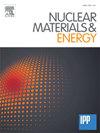EAST 2021 年活动后等离子体面材料上材料沉积和燃料滞留的事后分析
IF 2.3
2区 物理与天体物理
Q1 NUCLEAR SCIENCE & TECHNOLOGY
引用次数: 0
摘要
等离子体壁相互作用(PWI)对等离子体面材料(PFMs)的寿命、燃料保持和等离子体性能有重大影响,因此是托卡马克的一个关键问题。2020 年,先进超导托卡马克实验装置(EAST)的 PFMs 升级为主要为金属壁。在 2021 年的实验活动之后,对 PFM 表面沿极坐标和环坐标方向的沉积分布和燃料保留情况进行了分析。极环形试验从高场侧(HFS)开始,到下分流器,再到低场侧(LFS),最后到上分流器。环形试验在 HFS 的中平面进行,从端口 A 开始,到端口 P 结束。从第一壁和内部不锈钢(SS)部件溅射出的钼和铁颗粒容易沉积在分流器下部区域,这一点可以从内部分流器远太阳区域的元素含量显示钼和铁峰值,以及外部分流器近太阳和远太阳区域的元素含量显示钼和铁峰值得到证明。此外,还观察到 W 和 Fe 的快速再沉积,这表现在它们在侵蚀源附近的含量高于沿 HFS 环形第一壁较远处的含量。这种趋势在 W 方面比在 Fe 方面更为明显。进一步分析表明,沉积物由 Li、C、O、W、Mo、Fe、Cu 和 Ni 组成。锂和铁的含量远高于其他金属杂质,峰值分别为 8.17 μg/mm2 和 7.78 μg/mm2。沿 HFS 第一壁的锂含量从 P-2 时的 8.17 μg/mm2 降至 P-22 时的 1.82 μg/mm2,然后在分流器内 P-32 时增至 2.72 μg/mm2,而在 HFS 顶面和中面周围的铁含量较高。沉积的锂来自常规壁面调节,主要以 Li2CO3 的形式存在。此外,沉积在 Li2CO3 表面的其他金属杂质呈现出各种不规则形状,通常表现为聚集和再结晶的小颗粒。此外,在 HFS 上所有分析过的碳化硅涂层石墨瓦片上都测量到了大量的氘 (D) 保留,数量级为 1021 个原子/平方米。位于中平面 P-10 位置的 D 含量沿 HFS 的极坐标方向最高,因为该位置直接面对 NBI 光束。本文章由计算机程序翻译,如有差异,请以英文原文为准。
Post-mortem analysis of material deposition and fuel retention on the plasma-facing materials after the 2021 campaign in EAST
Plasma-wall interaction (PWI) is a critical concern in tokamaks because of its significant impact on the lifetimes of plasma-facing materials (PFMs), fuel retention, and plasma performance. In 2020, the Experimental Advanced Superconducting Tokamak (EAST) PFMs were upgraded to predominantly metallic walls. Following the 2021 experimental campaign, the deposition distribution and fuel retention on the surfaces of the PFMs along both the poloidal and toroidal directions were analyzed. The poloidal tests commenced at the high-field side (HFS), proceeded to the lower divertor, then to the low-field side (LFS), and finally to the upper divertor. The toroidal tests were performed at the midplane of the HFS, beginning from port A and ending at port P. The distributions of the deposits in the poloidal and toroidal directions were clearly asymmetrical. Mo and Fe particles sputtered from the first wall and inner stainless steel (SS) components were prone to deposition in the lower divertor region, as evidenced by the fact that the elemental content in the far-SOL region of the inner divertor exhibited Mo and Fe peaks, as did both the near- and far-SOL regions of the outer divertor. In addition, quick re-deposition of W and Fe was observed, as demonstrated by the fact that their contents near the erosion sources were higher than those farther away along the toroidal first wall on the HFS. This tendency was stronger for W than for Fe. Further analysis indicated that the deposits consisted of Li, C, O, W, Mo, Fe, Cu, and Ni. The Li and Fe contents were much higher than those of other metal impurities, with peak values of 8.17 μg/mm2 and 7.78 μg/mm2, respectively. The Li content decreased along the HFS first wall from 8.17 μg/mm2 at P-2 to 1.82 μg/mm2 at P-22, and then increased to 2.72 μg/mm2 at P-32 in the divertor, while the Fe content was higher around the top side and the midplane of the HFS. The deposited Li originated from routine wall conditioning and existed primarily in the form of Li2CO3. Additionally, other metal impurities deposited on the Li2CO3 surfaces exhibited various irregular shapes, often appearing as aggregated and recrystallized small particles. Furthermore, significant deuterium (D) retention on the order of 1021 atoms/m2 was measured on all the analyzed SiC-coated graphite tiles on the HFS. The D content at location P-10 at the midplane was the highest along the poloidal direction of the HFS because it was directly facing the NBI beam.
求助全文
通过发布文献求助,成功后即可免费获取论文全文。
去求助
来源期刊

Nuclear Materials and Energy
Materials Science-Materials Science (miscellaneous)
CiteScore
3.70
自引率
15.40%
发文量
175
审稿时长
20 weeks
期刊介绍:
The open-access journal Nuclear Materials and Energy is devoted to the growing field of research for material application in the production of nuclear energy. Nuclear Materials and Energy publishes original research articles of up to 6 pages in length.
 求助内容:
求助内容: 应助结果提醒方式:
应助结果提醒方式:


